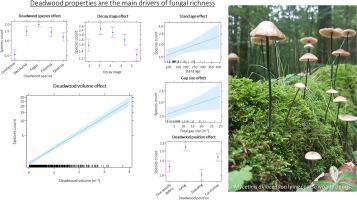当前位置:
X-MOL 学术
›
Forest Ecol. Manag.
›
论文详情
Our official English website, www.x-mol.net, welcomes your
feedback! (Note: you will need to create a separate account there.)
Quality of substrate and forest structure determine macrofungal richness along a gradient of management intensity in beech forests
Forest Ecology and Management ( IF 3.7 ) Pub Date : 2020-12-01 , DOI: 10.1016/j.foreco.2020.118512 Anita Atrena , Gaia Giedrė Banelytė , Thomas Læssøe , Rasmus Riis-Hansen , Hans Henrik Bruun , Carsten Rahbek , Jacob Heilmann-Clausen
Forest Ecology and Management ( IF 3.7 ) Pub Date : 2020-12-01 , DOI: 10.1016/j.foreco.2020.118512 Anita Atrena , Gaia Giedrė Banelytė , Thomas Læssøe , Rasmus Riis-Hansen , Hans Henrik Bruun , Carsten Rahbek , Jacob Heilmann-Clausen

|
Abstract The richness of saproxylic species is commonly found to be compromised in managed forests. However, it is often less clear if this reflects local scarcity of high quality deadwood objects or changes to the overall forest structure. Further, anthropogenic and natural drivers working at the landscape scale may have a strong impact. Hence, it is difficult to give detailed advice on how to conserve biodiversity in a cost-effective manner. Here we explored macrofungal richness on deadwood across a gradient of forest management intensity in Danish Fagus sylvatica forests. We aimed to disentangle the importance of habitat quality per se from the effects of variables recorded at the forest stand and landscape scales. Data was collected from 40 beech stands, each representing one of four broad management types: conventionally managed, near-to-nature managed, recently unmanaged and long unmanaged. Stands were aggregated within six larger forest clusters, to account for variation at the landscape scale. Fungal species were recorded as fruitbodies on deadwood at five decay stages. We found that the four management types showed strong differences in fungal richness, deadwood volume and forest structure, with long unmanaged stands having notably higher structural complexity and species richness. Fungal species richness and presence of red-listed fungi appeared to be mainly driven by deadwood volume, tree species and decay stage, but some stand-level variables such as canopy gaps, basal area and stand age were also of importance. Lying coarse deadwood had the highest species richness while standing coarse woody debris and fine deadwood had lower species density. Saproxylic fungal richness on individual deadwood objects was largely affected by resource quality and size, which is often limited in managed forests. Our results indicate that the best measure to increase fungal species richness, especially in managed stands, is to increase the amount of large diameter deadwood.
中文翻译:

基质质量和森林结构决定了山毛榉林中沿管理强度梯度的大型真菌丰富度
摘要 在管理的森林中,腐木物种的丰富度通常受到损害。然而,这是否反映了当地优质枯木物体的稀缺或整体森林结构的变化,通常不太清楚。此外,在景观尺度上工作的人为和自然驱动因素可能会产生很大的影响。因此,很难就如何以具有成本效益的方式保护生物多样性提供详细的建议。在这里,我们探索了丹麦山毛榉森林中森林管理强度梯度的枯木上的大型真菌丰富度。我们旨在将栖息地质量本身的重要性与在林分和景观尺度上记录的变量的影响分开。数据来自 40 个山毛榉林分,每个林分代表四种广泛的管理类型之一:常规管理、近乎自然的管理、近期未管理和长期未管理。林分聚集在六个较大的森林集群中,以解释景观尺度的变化。真菌物种在五个腐烂阶段被记录为枯木上的子实体。我们发现四种经营类型在真菌丰富度、枯木量和森林结构方面表现出很大差异,长期未经营林分具有显着更高的结构复杂性和物种丰富度。真菌物种丰富度和红色名录真菌的存在似乎主要受枯木量、树种和腐烂阶段驱动,但一些林分水平变量,如冠层间隙、基面积和林龄也很重要。平躺的粗枯木物种丰富度最高,而站立的粗木屑和细枯木的物种密度较低。个别枯木物体上的腐生真菌丰富度在很大程度上受资源质量和大小的影响,这在管理的森林中通常是有限的。我们的结果表明,增加真菌物种丰富度的最佳措施,尤其是在管理林分中,是增加大直径枯木的数量。
更新日期:2020-12-01
中文翻译:

基质质量和森林结构决定了山毛榉林中沿管理强度梯度的大型真菌丰富度
摘要 在管理的森林中,腐木物种的丰富度通常受到损害。然而,这是否反映了当地优质枯木物体的稀缺或整体森林结构的变化,通常不太清楚。此外,在景观尺度上工作的人为和自然驱动因素可能会产生很大的影响。因此,很难就如何以具有成本效益的方式保护生物多样性提供详细的建议。在这里,我们探索了丹麦山毛榉森林中森林管理强度梯度的枯木上的大型真菌丰富度。我们旨在将栖息地质量本身的重要性与在林分和景观尺度上记录的变量的影响分开。数据来自 40 个山毛榉林分,每个林分代表四种广泛的管理类型之一:常规管理、近乎自然的管理、近期未管理和长期未管理。林分聚集在六个较大的森林集群中,以解释景观尺度的变化。真菌物种在五个腐烂阶段被记录为枯木上的子实体。我们发现四种经营类型在真菌丰富度、枯木量和森林结构方面表现出很大差异,长期未经营林分具有显着更高的结构复杂性和物种丰富度。真菌物种丰富度和红色名录真菌的存在似乎主要受枯木量、树种和腐烂阶段驱动,但一些林分水平变量,如冠层间隙、基面积和林龄也很重要。平躺的粗枯木物种丰富度最高,而站立的粗木屑和细枯木的物种密度较低。个别枯木物体上的腐生真菌丰富度在很大程度上受资源质量和大小的影响,这在管理的森林中通常是有限的。我们的结果表明,增加真菌物种丰富度的最佳措施,尤其是在管理林分中,是增加大直径枯木的数量。

































 京公网安备 11010802027423号
京公网安备 11010802027423号